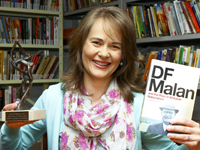
Lindie Koorts
Photo: Hannes Pieterse |
Sometimes fact is stranger than fiction. In this case, it is not only true, but fact is stirring up more of a buzz than make-belief does.
The first biography of an apartheid Prime Minister written since 1994, won an award at the 2014 Woordfees. ‘DF Malan and the Rise of Afrikaner Nationalism’ is the title of the book causing this national whirlwind. The author: Lindie Koorts – a postdoctoral fellow at the UFS’s Centre for Africa Studies.
She admits she was among the most surprised when she won the category for Debut Writers. “This is, as far as I know, the first time this prize goes to a non-fiction writer,” Koorts said.
What started as curiosity around DF Malan, four years later culminated in an objective biography devoid of justification or exoneration. “Throughout the process of writing, I offer the facts, but I do not clamber in with moralistic judgements,” Koorts said.
In addition to Malan the politician, Koorts discovered Malan the human being as well during her research. When she stumbled on his hand-written love letters to Maria Louw, which he wrote when he was in his 60s, a totally different man emerged. “I felt like a teenager while reading those letters!” Koorts laughed.
In the chapter entitled Coalition and Fusion, this dynamic historian unearthed a fact that had the power to change the course of history. Up until this point, the belief was held that one party deceived another. However, Koorts’ research proves that the entire issue rested on a letter that did not arrive on time. A case of tardy train schedules and a mere misunderstanding.
“To be able to unravel these things makes one feel that you have succeeded in something,” she said.
Not only did she succeed in writing an award-winning biography, she surely will be making history as she goes.